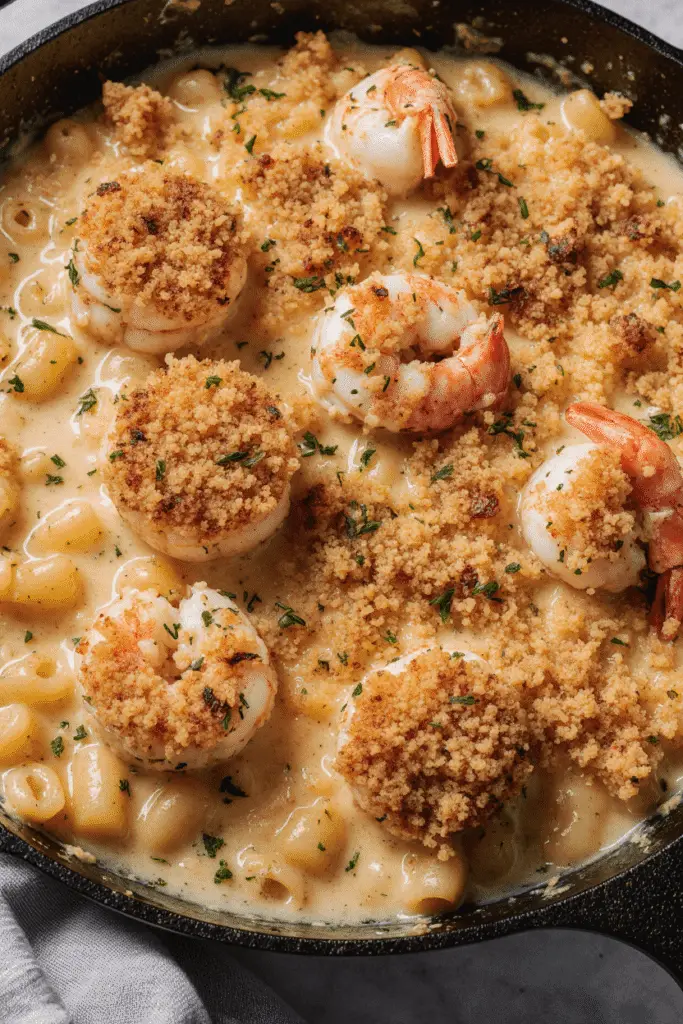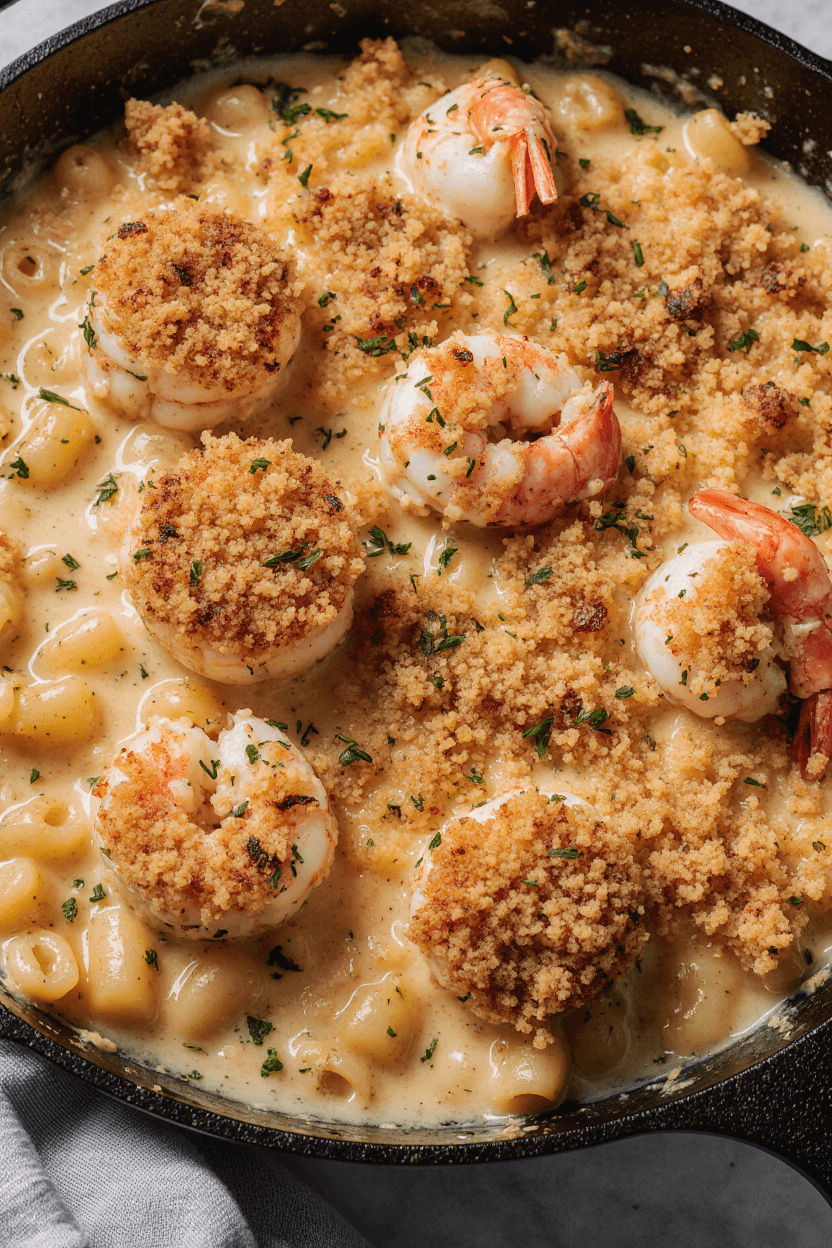Creamy Seafood Mac and Cheese: The Perfect Comfort Dish
Have you ever wondered how to take the classic comfort food, mac and cheese, to a whole new level of indulgence? Seafood Mac and Cheese offers a luscious twist on the traditional dish, combining creamy, cheesy pasta with the rich, savory flavors of lobster, crab, or shrimp. But mastering this decadent dish isn’t always straightforward—balancing seafood’s delicate taste with the richness of cheese can be tricky without turning it too heavy or rubbery.
In this post, we will guide you through how to create the perfect creamy seafood pasta that hits all the right notes. Whether you’re craving lobster mac and cheese for a special occasion or a comforting dinner, you’ll find everything you need to make this restaurant-quality dish at home.
Ingredients List for Creamy Seafood Pasta
Here’s everything you’ll need to craft this irresistible seafood mac and cheese, including substitutions to accommodate various dietary needs:
- 8 ounces elbow macaroni (or cavatappi for extra texture)
- 1 pound mixed seafood (lobster meat, shrimp, crab meat, or scallops)
- Substitution: Use canned crab or cooked shrimp for convenience.
- 4 tablespoons unsalted butter
- 1/4 cup all-purpose flour
- Gluten-free alternative: Use rice flour or gluten-free all-purpose flour.
- 3 cups whole milk (warm)
- Dairy-free option: Substitute with unsweetened almond or oat milk.
- 1 cup sharp white cheddar cheese (grated)
- 1 cup Gruyère cheese (grated)
- Alternative: Substitute Gruyère with fontina or mozzarella.
- 1/2 cup Parmesan cheese (freshly grated)
- 2 teaspoons Dijon mustard
- 1/2 teaspoon smoked paprika
- Salt and freshly ground black pepper, to taste
- 1 teaspoon lemon zest
- 2 cloves garlic, minced
- 2 tablespoons fresh parsley, chopped (for garnish)
- Optional: A pinch of cayenne pepper for subtle heat
Timing: Prep, Cook, and Savor
- Prep Time: About 15 minutes to chop seafood, shred cheese, and get ingredients ready.
- Cook Time: 25 minutes, including preparing the pasta, making the cheese sauce, and baking.
- Total Time: Approximately 40 minutes from start to finish.
Imagine the aroma of garlic and melted cheese mingling with fresh seafood filling your kitchen — a sensory delight that signals a meal worth waiting for.

Step-by-Step Instructions for Perfect Lobster Mac and Cheese
Step 1: Prepare and Cook the Pasta
Bring a large pot of salted water to a boil. Add the macaroni and cook according to package instructions until al dente—firm but tender. Drain and set aside, reserving a cup of pasta water for later use.
Chef’s Tip: Slightly undercook the pasta since it will bake afterward; this prevents mushiness.
Step 2: Sauté Seafood Gently
In a large skillet over medium heat, melt 1 tablespoon butter. Add minced garlic and sauté for 1 minute until fragrant. Add the seafood and cook just until opaque—about 2-3 minutes for shrimp or lobster.
Pro advice: Avoid overcooking your seafood to maintain a tender texture. Remove it from the pan and set aside.
Step 3: Make the Creamy Cheese Sauce
In a medium saucepan, melt the remaining butter over medium heat. Whisk in the flour and cook for 1-2 minutes to form a smooth roux. Gradually add warm milk, whisking constantly to avoid lumps. Continue cooking until the sauce thickens, about 5 minutes.
Stir in Dijon mustard, smoked paprika, lemon zest, and season with salt and pepper. Remove from heat, then stir in the cheddar, Gruyère, and half of the Parmesan cheese until fully melted and creamy.
Step 4: Combine Pasta, Seafood, and Cheese Sauce
Fold the cooked pasta and seafood into the cheese sauce gently. If the mixture is too thick, add a splash of reserved pasta water to loosen it up.
Step 5: Bake to Golden Perfection
Preheat your oven to 350°F (175°C). Transfer the cheesy seafood pasta to a greased baking dish. Sprinkle the remaining Parmesan on top for a crunchy crust.
Bake for 15-20 minutes, until bubbly and golden on top.
Chef’s tip: For extra crispiness, broil the top for the last 2 minutes—watch closely to prevent burning.
Nutritional Information
- Calories: Approximately 550 per serving
- Protein: 30g (seafood is a great lean protein source)
- Carbohydrates: 45g
- Fats: 25g (focus on healthy fats from seafood and moderation in cheese)
- Calcium: High (from milk and cheese)
- Omega-3 fatty acids: Beneficial levels, thanks to seafood
- Sodium: Moderate – adjust salt to taste
Healthier Alternatives That Don’t Compromise Flavor
- Use whole wheat or legume-based pasta to boost fiber content.
- Swap half or all of the cheese with low-fat versions or nutritional yeast for a cheesy flavor with fewer calories.
- Incorporate veggies like spinach or peas into the pasta for extra vitamins and antioxidants.
- Replace half the butter with olive oil to increase heart-healthy monounsaturated fats.
- Use cauliflower puree blended into the sauce to create creaminess with fewer carbs.
Serving Suggestions for Seasonal and Flavorful Pairings
Seafood mac and cheese pairs beautifully with:
- A light, crisp green salad dressed in lemon vinaigrette to cut through richness.
- Roasted asparagus or garlic sautéed green beans for color and crunch.
- A chilled glass of Sauvignon Blanc or Chardonnay, whose acidity complements creamy dishes.
- Serve as a decadent side alongside grilled or pan-seared fish for seafood lovers.
For a festive touch, garnish with freshly chopped herbs like tarragon or chives, or zest some fresh lemon juice over the top just before serving.
Common Mistakes to Avoid
- Overcooking seafood: Leads to rubbery texture; cook just until it turns opaque.
- Not thickening the sauce properly: A runny cheese sauce will make the dish soggy.
- Skipping the roux: Flour and butter mixture is essential for smooth sauce without lumps.
- Using pre-shredded cheese: Often contains anti-caking agents that can affect melting.
- Overbaking: Can dry out the pasta; bake only until bubbly and golden.
Storing Tips to Maintain Freshness
- Cool leftovers to room temperature before refrigerating in an airtight container.
- Store for up to 3 days in the fridge.
- To reheat, cover with foil and bake at 350°F until warmed through, or gently heat on the stovetop with a splash of milk to restore creaminess.
- Avoid microwaving uncovered to prevent drying out.
Conclusion: Savor the Ultimate Comfort Food Upgrade
Seafood mac and cheese is the perfect blend of comfort, elegance, and flavor. By following simple steps and keeping these expert tips in mind, you can recreate this creamy seafood pasta masterpiece at home. Don’t forget to share your experience or ask questions in the comments below—let’s make your next dinner unforgettable!
FAQs About Creamy Seafood Pasta
Q1: Can I use frozen seafood for this recipe?
Absolutely! Just thaw it fully and pat dry to remove excess moisture before cooking, ensuring it sautés nicely without steaming.
Q2: What’s the best cheese for mac and cheese with seafood?
A blend of sharp cheddar and Gruyère creates a melty, flavorful base. Parmesan adds depth and a crispy topping.
Q3: How can I prevent the mac and cheese from becoming too heavy?
Use lighter milk alternatives, add veggies, and balance richness with acidic sides like lemon-dressed salads.
Q4: Can this dish be made ahead and frozen?
Yes, but the texture might change slightly. Freeze before baking, and thaw overnight before cooking as directed.
Q5: What wine pairs well with lobster mac and cheese?
Choose crisp whites like Sauvignon Blanc or buttery Chardonnay to complement the creamy seafood flavors.
For more decadent comfort food recipes, check out our classic Cheesy Baked Ziti or Shrimp Scampi Pasta. Also, don’t miss our guide on How to Perfectly Cook Pasta Every Time for kitchen essentials!

